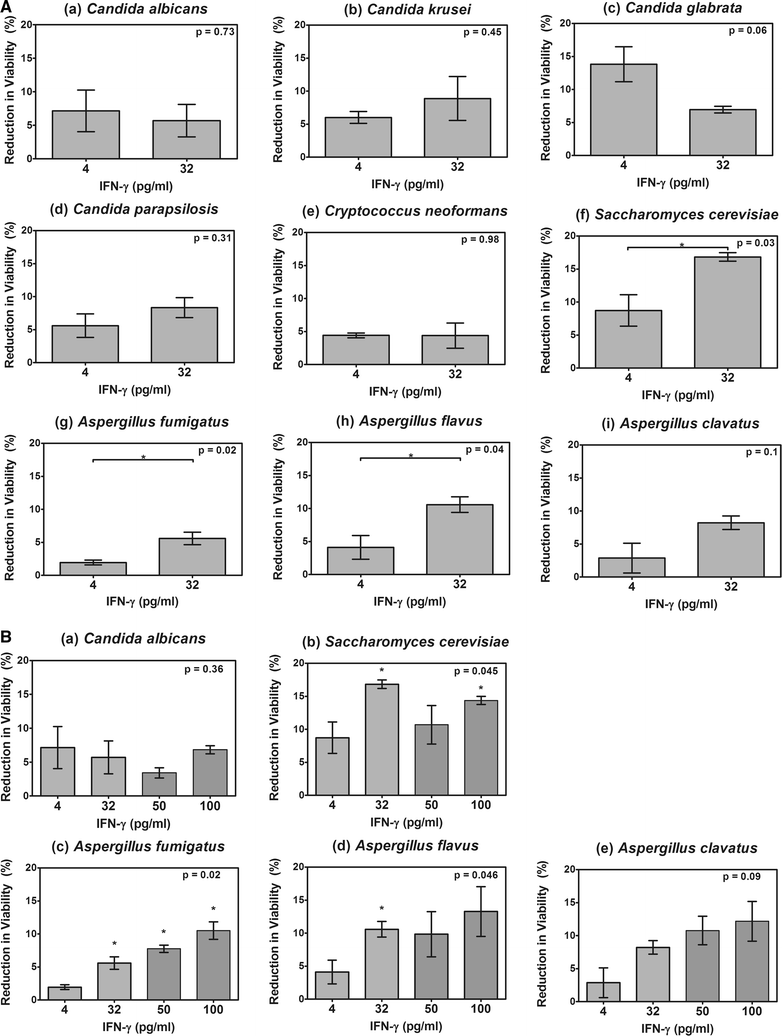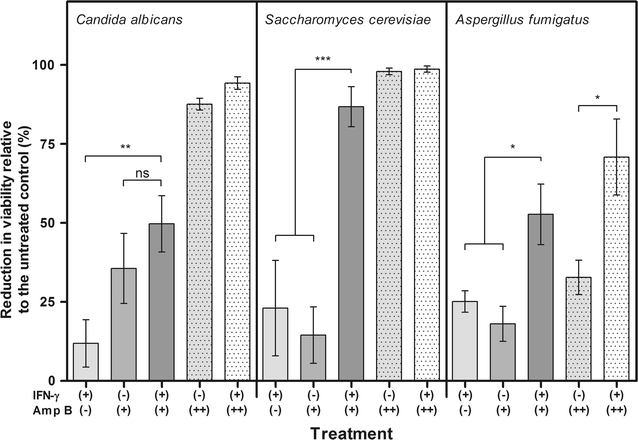The in vitro effects of interferon-gamma, alone or in combination with amphotericin B, tested against the pathogenic fungi Candida albicans and Aspergillus fumigatus
- PMID: 28764751
- PMCID: PMC5539893
- DOI: 10.1186/s13104-017-2696-4
The in vitro effects of interferon-gamma, alone or in combination with amphotericin B, tested against the pathogenic fungi Candida albicans and Aspergillus fumigatus
Abstract
Objective: Recent studies into the antifungal activity of NK-cells against the Aspergillus fumigatus have presented differing accounts on their mode of antifungal activity. One of these mechanisms proposed that NK-cells may kill the fungus via the direct effects of exposure to Interferon gamma (IFN-γ).
Results: In this study we investigated the direct antifungal effects of recombinant human IFN-γ against a range of pathogenic fungi by measuring cellular damage using an XTT-based assay and cell viability through plate counts. It was found that 32 pg/ml of IFN-γ exhibited a significant but small antifungal effect on A. fumigatus (p = 0.02), Aspergillus flavus (p = 0.04) and Saccharomyces cerevisiae (p = 0.03), inhibiting growth by 6, 11 and 17% respectively. No significant inhibitory effects were observed in Candida species (p > 0.05 for all species tested) or Cryptococus neoformans (p = 0.98). Short term exposure (3 h) to a combination of amphotericin B (1 µg/ml) and IFN-γ (32 pg/ml) increased the effectiveness of amphotericin B against A. fumigatus and S. cerevisiae but not Candida albicans. These data suggest that IFN-γ does not possess strong antifungal activity but can enhance the effect of amphotericin B under some testing conditions against Aspergillus species.
Keywords: Amphotericin B; Antifungals; Aspergillosis; Interferon-gamma.
Figures


References
-
- Calton EA, Le Doare K, Appleby G, Chisholm JC, Sharland M, Ladhani SN, Participants C. Invasive bacterial and fungal infections in paediatric patients with cancer: incidence, risk factors, aetiology and outcomes in a UK regional cohort 2009–2011. Pediatr Blood Cancer. 2014;61(7):1239–1245. doi: 10.1002/pbc.24995. - DOI - PubMed
-
- Munoz P, Ceron I, Valerio M, Palomo J, Villa A, Eworo A, Fernandez-Yanez J, Guinea J, Bouza E. Invasive aspergillosis among heart transplant recipients: a 24-year perspective. J Heart Lung Transplant Off Publ Int Soc Heart Transplant. 2014;33(3):278–288. doi: 10.1016/j.healun.2013.11.003. - DOI - PubMed
MeSH terms
Substances
LinkOut - more resources
Full Text Sources
Other Literature Sources

